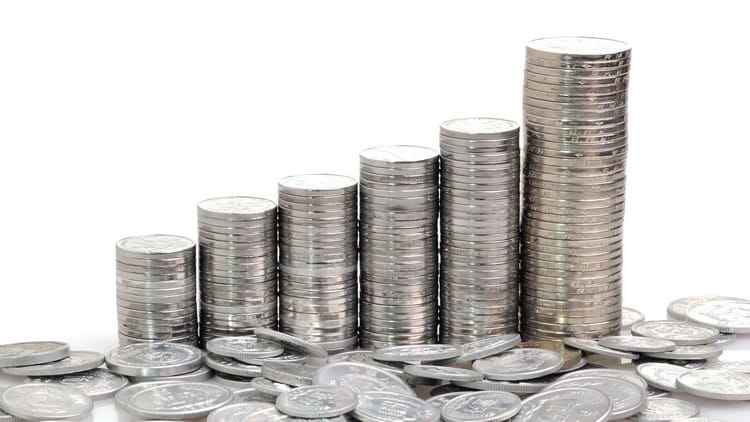
Antique silver coins of Austria can be divided into three groups. Those are thalers, kreuzers, coronas, and shillings. Every type was minted in Austrian mint depending on the ongoing monetary reforms or the head of the state.
Silver thaler
Thaler is a silver coin that was used in Europe, including Austria, during XVI-XIX centuries. The coin design was changing depending on the king. It was presented in one denomination only.
1 thaler of Archduke Leopold V
- Year of minting: 1630
- Obverse: portrait of Archduke Leopold V in the crown with a scepter in his right hand and a sword in his left one; year of minting; inscription «LEOPOLDVS:D:G:ARCHI:DVX:AVSTRIAE».
- Reverse: coat of arms with the crown on the top; inscription «COMES:TIROLI:DVX:BVR G ND I:»; sacrificial lamb at the bottom.
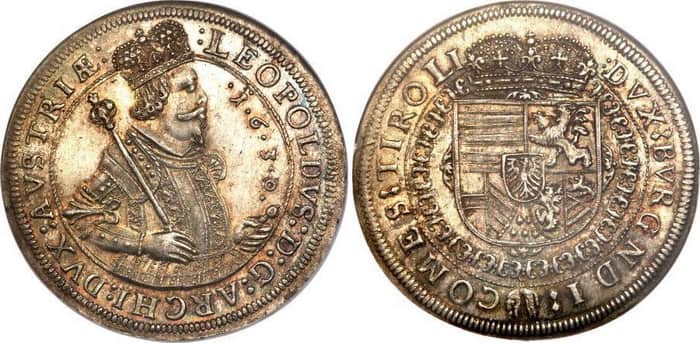
1 thaler of Ferdinand I
- Year of minting: 1842
- Obverse: portrait of Ferdinand I with the laurel wreath; inscription «FERD*I*D*G*AVSTR*IMP*HVNG*BOH*R*H*N*V*».
- Reverse: two-headed eagle with three crowns, coat of arms, scepter, sword, and orb; inscription «GAL-LOD-ILL*A*A*1842*REX*LOMB*ET*VEN*DALM*».
Austrian 1 Thaler 1842 silver coins in GoldAdvert catalog.

The Vereinsthaler
- Year of minting: 1857-1861
- Obverse: portrait of a woman, who personifies the city of Frankfurt am Main; inscription «FREIE STADT FRANKFURT»; dotted line decoration.
- Reverse: eagle with a crown on its head; inscription «ZWEI VEREINSTHALER.XV EIN PFUND FEIN. 1861»; dotted line decoration.
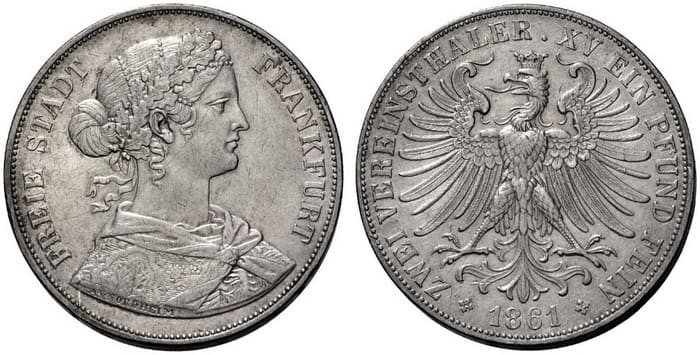
Interesting fact: The Vereinsthaler was minted due to the German-Austrian monetary convention, signed on January 24, 1857. The coinage was limited to thirty copies. They were made from a pound of 90 % silver, which exceeded the fineness of silver of the Prussian thaler minted in 1750-1856.
Silver kreuzers
The minting of silver kreuzers in Austrian Empire began in 1458-1460. The name of the coin comes from the word “kreuz”, which means “the cross” because the symbol of the Viennese cross was depicted on the first copper coins.
3 kreuzers
- Year of minting: 1698
- Obverse: portrait of Leopold I; inscription «IMPER:S:A*LEOPOLDVS:D:G:R:»; denomination.
- Reverse: two-headed eagle with one crown on the neck and another above the head, with coat of arms, sword, and scepter; inscription «G*E» under it; inscription «HEMIAE:REX*1698*GER:HVN:B» on the edge of the coin.

5 kreuzers
- Year of minting: 1858-1865
- Obverse: portrait of young Franz Joseph I with a laurel wreath; dotted line decoration; inscription «FRANZ JOSEPH I*V*G*G*KAISER V*OESTERREICH».
- Reverse: two crossed twigs of laurel and palm-tree; denomination; crown above it; inscription «SCHEIDE MUNZE».
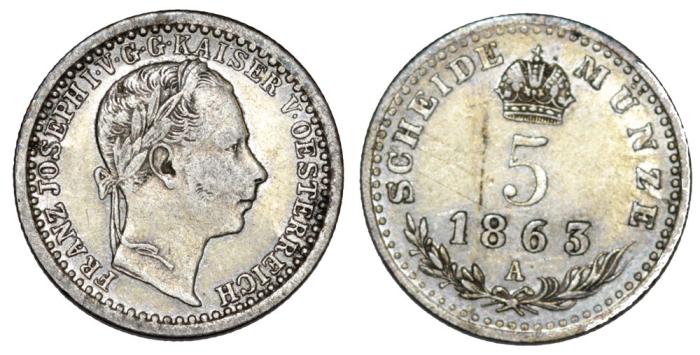
- Year of minting: 1858-1865
- Obverse: portrait of the king Ferdinand I with a laurel wreath; beaded border; inscription «FERD*I*D*G*AVSTR*IMP*HVNG*BOH*R*H*N*V C».
- Reverse: two-headed eagle with three crowns, coat of arms, scepter, sword, and orb; beaded border; inscription «GAL*LOD*ILL*A*A*1840*REX*LOMB*ET*VEN*DALM*5».
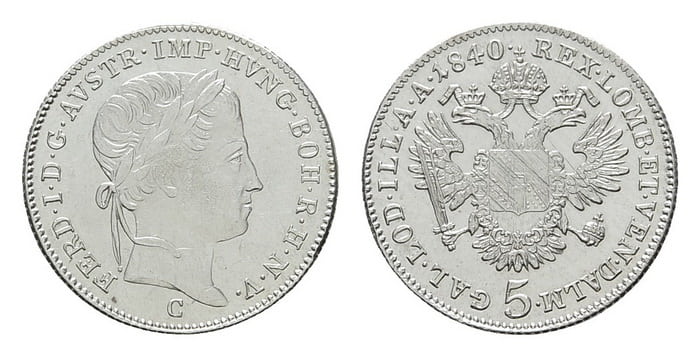
10 kreuzers
- Year of minting: 1765-1790
- Obverse: portrait of Archduke of Austria Joseph II framed by a laurel wreath; inscription «LOD*ILL*REX A*A*1869 HVNGAR*BOHEM*GAL».
- Reverse: two-headed eagle with the crown on its head, coat of arms, scepter, sword, and orb; denomination framed by a laurel wreath; inscription«EXEMPLO 1770*X VIRTUIE ET».
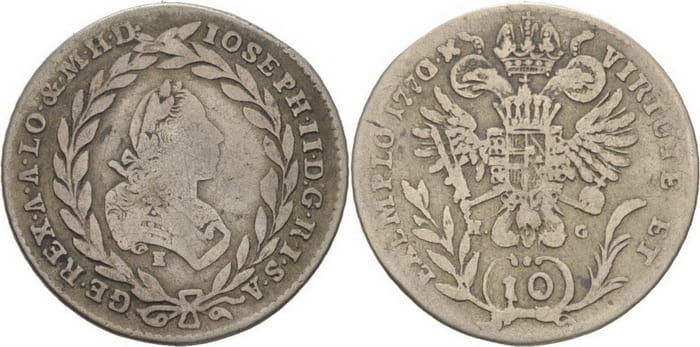
- Year of minting: 1868-1872
- Obverse: portrait of young Franz Joseph I with a laurel wreath; dotted line decoration; inscription «FRANC*IOS*I*D*G*AVSTRIAE IMPERATOR».
- Reverse: two-headed eagle with royal regalia (crown, scepter, sword, orb) and a shield with denomination on it; dotted line decoration; inscription «LOD*ILL*REX A*A*1869 HVNGAR*BOHEM*GAL».
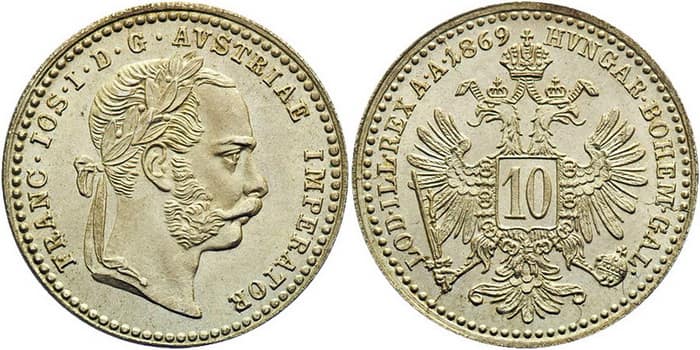
20 kreuzers
- Year of minting: 1758
- Obverse: portrait of the Empress of Austria Maria Theresa framed by the laurel wreath; inscription «M*THERESIA*D*G*R*IMP*GE*HU*E *REG».
- Reverse: two-headed eagle with two crowns and the coat of arms on a pedestal with the denomination on it; laurel twig on the left, palm-tree twig on the right; inscription «ARCHID*AUST*DUX*BURG*SI*MO*1758X».
Interesting fact: The book with records of the military court of the reign of Maria Theresa is stored in the Prague Museum. It records that each regiment had an executioner who was paid 1 thaler for the head of an executed soldier. Some days the executioner could receive up to 5 thalers.
Austrian 20 Kreuzers 1758 silver coins in GoldAdvert catalog.
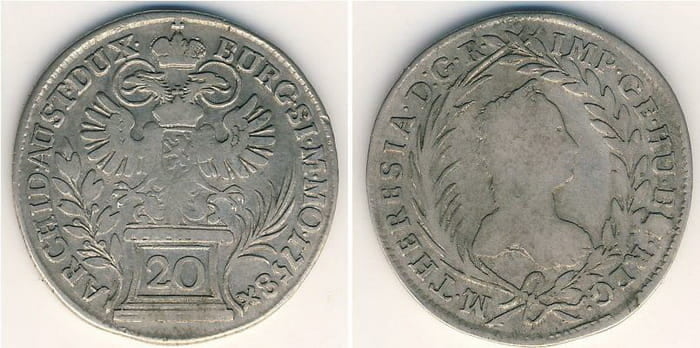
- Year of minting: 1804-1867
- Obverse: portrait of young Archduke of Austria Ferdinand I with a laurel wreath; beaded border; inscription «FERD*I*D*G*AVSTR*IMP*HVNG*BOH*R*H*N*V».
- Reverse: two-headed eagle with three crowns, coat of arms, scepter, sword, and orb; beaded border; inscription «GAL*LOD*ILL*A*A*1846*REX*LOMB*ET*VEN*DALM*20».
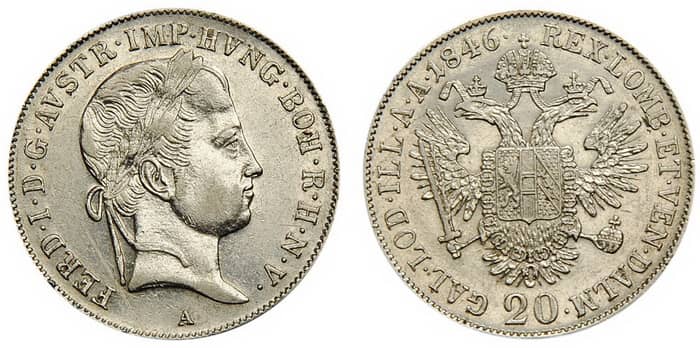
Silver coronas
After a protracted financial crisis, Austria implemented a monetary reform. Starting with August 2, 1892, the issue of gold and silver coronas had started. Silver coins were represented in 1, 2 and 5 corona denominations. After the Austro-Hungarian Empire collapse in 1918 these coins were slowly withdrawn from the circulation and substituted by shillings.
1 corona
- Year of minting: 1892-1913
- Edge: «VIRIBVS VNITIS»
- Obverse: portrait of the king Franz Joseph I; dotted line decoration; inscription «FRANC*IOS*I*D*G*IMP*AVSTR*REX BOH*GAL*ILL*ETC*ET AP*REX HVNC».
- Reverse: сrown; denomination and year of minting above it; laurel twigs on both sides; dotted line decoration.
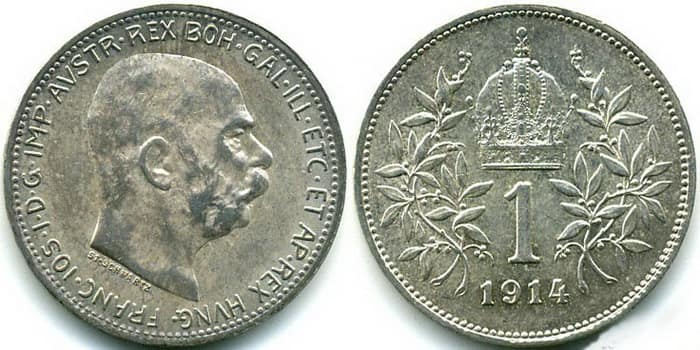
2 coronas
- Year of minting: 1912-1913
- Edge: «VIRIBVS VNITIS»
- Obverse: portrait of the king Franz Joseph I; dotted line decoration; inscription «FRANC*IOS*I*D*G*IMP*AVSTR*REX BOH*GAL*ILL*ETC*ET AP*REX HVNC».
- Reverse: two-headed eagle with a crown, coat of arms, sword, scepter, and orb; denomination and year of minting at the bottom.
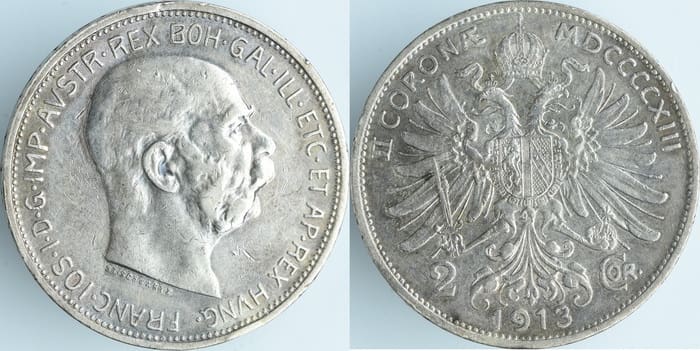
5 coronas
- Yearofminting: 1900-1909
- Гурт: «VIRIBVS VNITIS»
- Obverse: portrait of the king Franz Joseph I; dotted line decoration; inscription «FRANC*IOS*I*D*G*IMP*AVSTR*REX BOH*GAL*ILL*ETC*ET AP*REX HVNC».
- Reverse: two-headed eagle with royal regalia: a crown, coat of arms, sword, scepter, and orb; inscription «QVINQVE CORONA»; dotted line decoration; 5 small circles with crowns on them connected by laurel twigs in a circle; denomination and year of minting at the bottom.
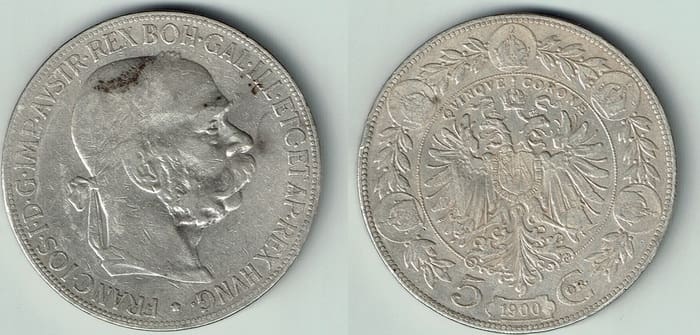
Interesting fact: A commemorative silver coin of 5 corona denomination was issued in 1908. It was dedicated to the 60th Anniversary of the reign of Franz Joseph I.
Silver shillings
Shillings replaced the depreciated corona. They were minted on the Austrian mint since March 1, 1925, until 1938. Silver coins of 1/2, 1, 2 and 5 shilling denominations were minted in that period.
1/2 shillings
- Year of minting: 1925-1926
- Obverse: equilateral rhomb with the denomination “1/2” in large letters “HALB SCHILLING”; year of minting between the letters.
- Reverse: shield; inscription «REPVBLIK*ÖESTERREICH».
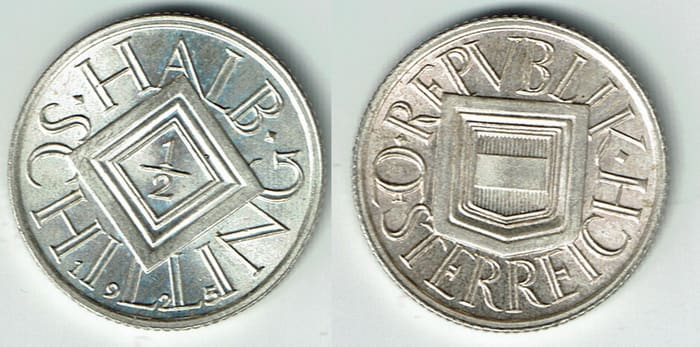
Interesting fact: The design of these coins was created by the artist Philip Hussler in the distinctive style of the 1920s.
1 shilling
- Year of minting: 1925-1932
- Obverse: Parliament building in Vienna; inscription «OESTERREICHREPUBLIK»; year of minting at the bottom.
- Reverse: shield on a foreground of edelweiss twigs; denomination «EIN SСHILLING».
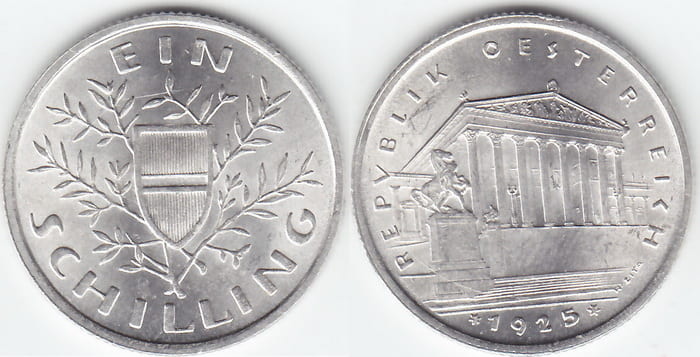
2 shillings
- Year of minting: 1937
- Obverse: facade of Karlskirche in Vienna; inscription «KARLSKIRCHE VOLLENDET 1737»; inscription «J*B*FISCHER*VON*ERLACH» at the top.
- Reverse: two-headed eagle with a shield; inscription «ÖESTERREICH»; denomination «2 S» and year of minting at the bottom.
Austrian 2 Shilings 1937 silver coins in GoldAdvert catalog.
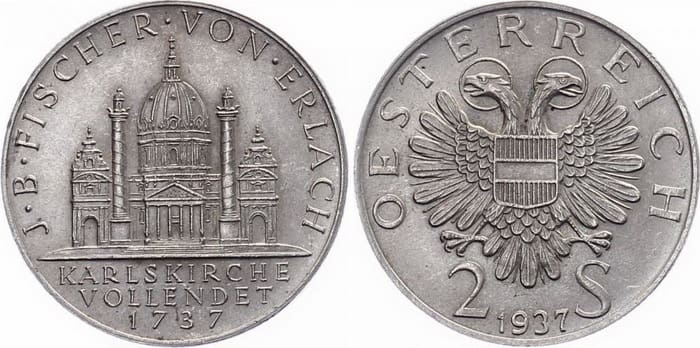
5 shillings
- Year of minting: 1934, 1935, 1936
- Obverse: image of the wooden sculpture «The Great Mother of Austria» in Mariazell; inscription «MAGNA*MATER*AUSTRIAE»; year of minting at the bottom.
- Reverse: two-headed eagle with a shield; inscription «ÖSTERREICH*FUNF SCHILLING».
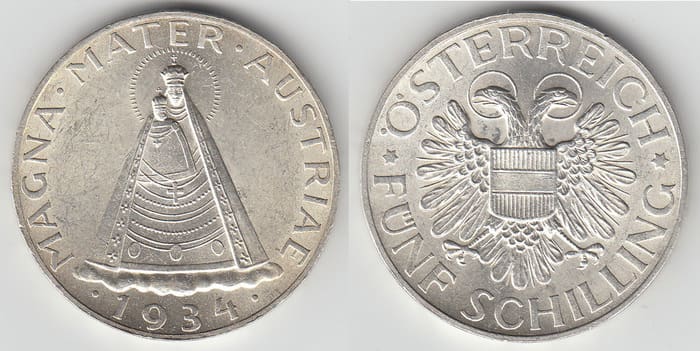
Interesting fact: The rarest of these coins have a 1934 year of minting because that coinage was almost completely remelted.
Which mint issued
Throughout the centuries, the Austrian mint issued various types of silver coins. This was not an accident. The history of the mint is connected closely with this noble metal. In 1194 Archduke Leopold took Richard Lionheart captive, who had to give a ransom for his freedom. This ransom was approximately 12 tons of silver. It was ordered to begin minting from this silver. Thus, the Austrian mint started its work and continued it to this day as part of the central Austrian Bank.
The cost of antique silver coins
The price of any of the presented coins is not fixed. It depends on many factors:

- period of minting;
- condition;
- rareness;
- fineness of silver;
- demand on the market;
- price of a troy ounce of silver on major world exchanges in London, New York, and Shanghai.
For example, the price of silver coins can vary within such limits on numismatic exchanges and auctions:
- thalers – 35-80 euros;
- kreuzers – 6-40 euros;
- coronas – 4-20 euros;
- shillings – 2-16 euros.
Comments
No commens yet.